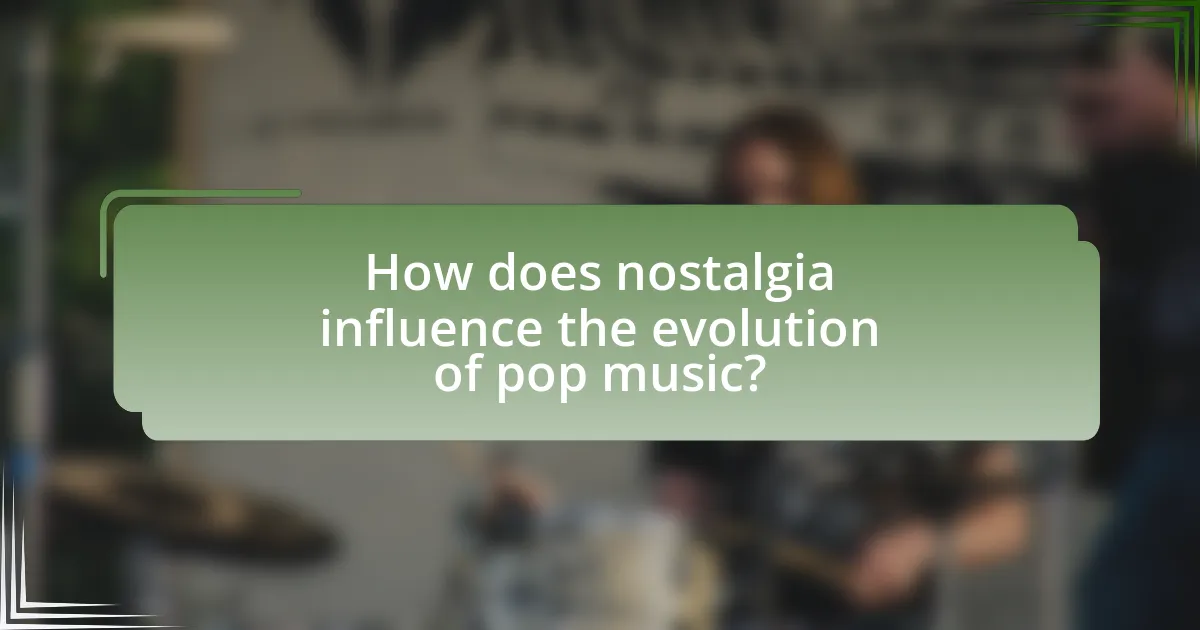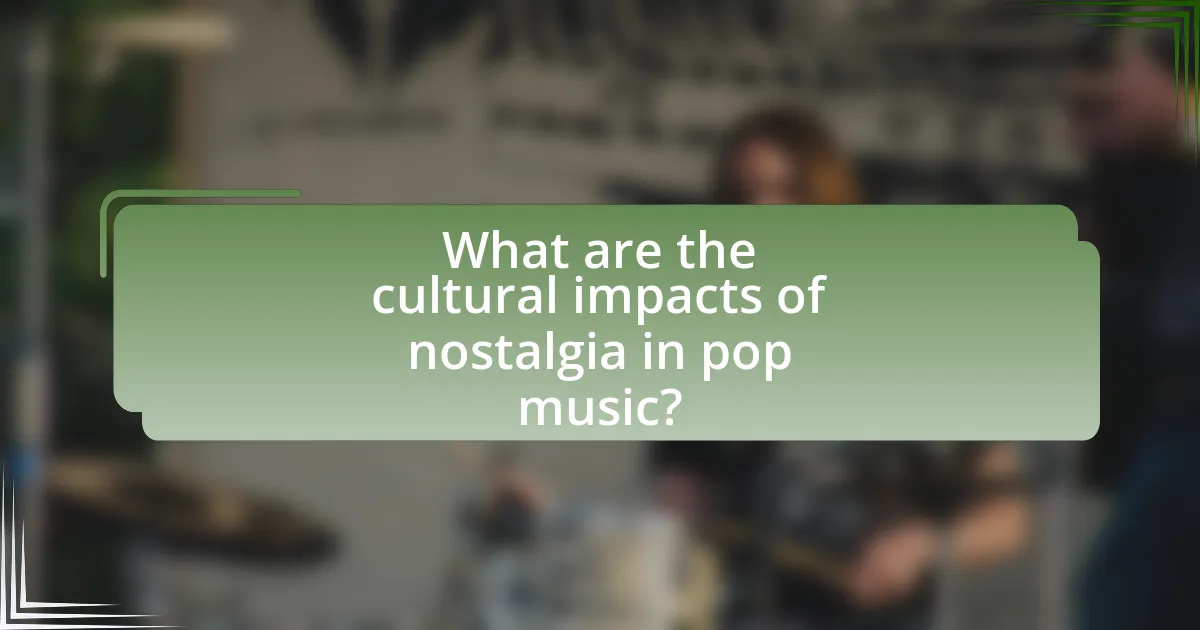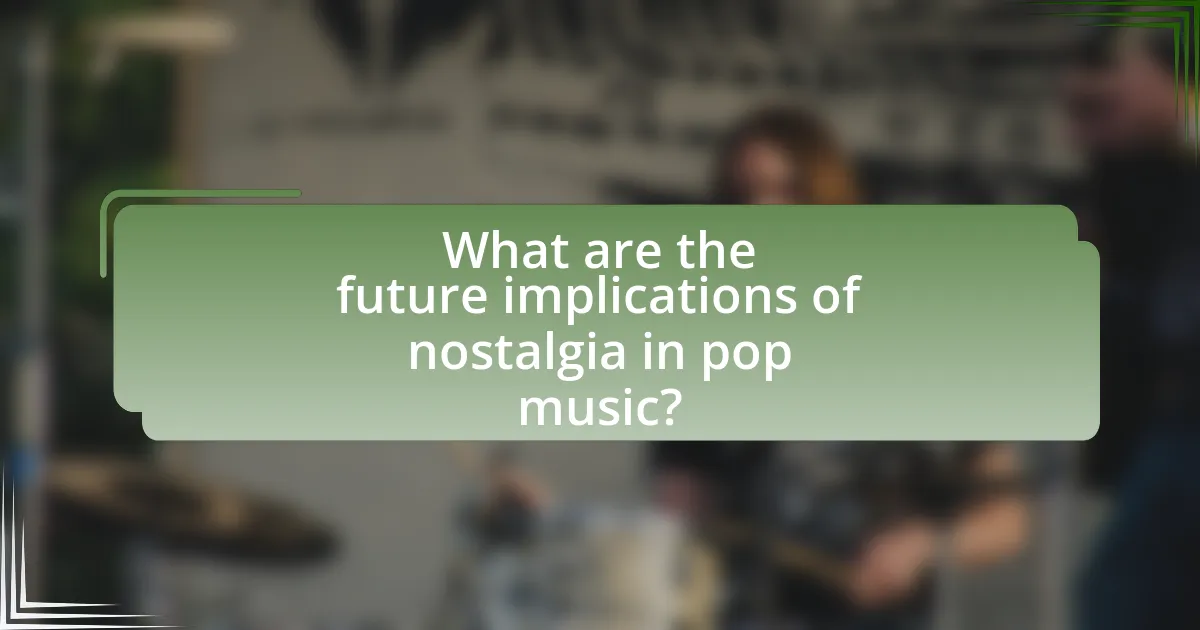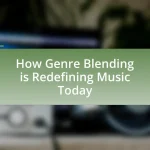Nostalgia plays a crucial role in shaping the evolution of pop music by encouraging artists to incorporate elements from past musical styles and trends. This article explores how nostalgia influences contemporary pop music through the resurgence of retro sounds, emotional connections, and cultural references. Key aspects include the emotional responses triggered by nostalgic melodies and lyrics, the impact of memories on musical preferences, and the strategies artists use to blend old and new styles. Additionally, the article examines the cultural implications of nostalgia in music, its effects on listener engagement, and the challenges faced by new artists in a nostalgia-driven market.

How does nostalgia influence the evolution of pop music?
Nostalgia significantly influences the evolution of pop music by driving artists to incorporate elements from past musical styles and trends. This phenomenon is evident in the resurgence of retro sounds, such as 1980s synth-pop and 1990s R&B, which have been popularized by contemporary artists like Dua Lipa and The Weeknd. Research indicates that nostalgia can evoke emotional responses, making listeners more receptive to familiar sounds, which in turn encourages artists to blend old and new styles to create commercially successful music. For instance, the Billboard charts have seen a rise in songs that sample or reference older hits, demonstrating how nostalgia shapes current pop music trends and consumer preferences.
What are the key elements of nostalgia in music?
The key elements of nostalgia in music include melody, lyrics, instrumentation, and cultural references. Melody often evokes emotional responses tied to past experiences, while lyrics can directly reference specific memories or eras, enhancing the nostalgic feeling. Instrumentation, particularly the use of vintage sounds or styles, can transport listeners back to a particular time, creating a sense of familiarity. Cultural references within songs, such as mentioning iconic events or figures, further anchor the music in a specific historical context, reinforcing the nostalgic experience. Studies have shown that nostalgia can enhance emotional well-being, making music that taps into these elements particularly resonant for listeners.
How do artists incorporate nostalgic elements into their songs?
Artists incorporate nostalgic elements into their songs by utilizing familiar sounds, themes, and cultural references that evoke memories of past eras. For instance, musicians often sample melodies or beats from previous decades, such as the use of 1980s synths in contemporary pop music, which creates a sense of familiarity and emotional connection for listeners. Additionally, lyrics may reference specific events, trends, or icons from the past, further enhancing the nostalgic experience. Research indicates that nostalgia can trigger positive emotions and enhance listener engagement, as seen in the popularity of retro-inspired genres like synthwave and the resurgence of vinyl records, which appeal to both older audiences and younger generations seeking authenticity.
What role do memories play in shaping musical preferences?
Memories significantly influence musical preferences by creating emotional connections to specific songs or genres. These connections often stem from personal experiences, such as significant life events or shared moments with others, which can evoke nostalgia. Research indicates that nostalgia enhances the enjoyment of music, as evidenced by a study published in the journal “Psychology of Music,” where participants reported stronger emotional responses to songs associated with positive memories. This emotional resonance can lead to a preference for music that reminds individuals of their past, shaping their overall musical tastes.
Why is nostalgia a powerful tool for pop music artists?
Nostalgia is a powerful tool for pop music artists because it evokes emotional connections and memories in listeners, enhancing their engagement with the music. This emotional resonance is supported by research indicating that nostalgic music can trigger positive feelings and a sense of belonging, which are critical for audience retention and loyalty. For instance, a study published in the journal “Psychology of Music” found that nostalgic songs can increase listeners’ mood and foster social connections, making them more likely to share and promote the music. By tapping into shared cultural references and past experiences, pop artists can create a compelling narrative that resonates deeply with their audience, ultimately driving commercial success and artistic relevance.
How does nostalgia evoke emotional responses in listeners?
Nostalgia evokes emotional responses in listeners by triggering memories associated with past experiences, often linked to significant life events or cultural moments. This emotional response occurs because nostalgia activates brain regions related to emotion and memory, such as the hippocampus and the prefrontal cortex. Research indicates that nostalgic music can enhance feelings of social connectedness and well-being, as evidenced by a study published in the journal “Emotion,” which found that listening to nostalgic songs can increase feelings of happiness and reduce feelings of loneliness. Thus, nostalgia serves as a powerful emotional catalyst, influencing listeners’ moods and connections to their past.
What psychological effects does nostalgia have on music consumption?
Nostalgia significantly influences music consumption by enhancing emotional connections and increasing the likelihood of revisiting past music experiences. This emotional response is rooted in nostalgia’s ability to evoke memories associated with specific songs or genres, leading to a sense of comfort and familiarity. Research indicates that nostalgic music can trigger positive emotions, reduce feelings of loneliness, and even improve mood, as demonstrated in studies like “Nostalgia: A Psychological Resource” by Routledge et al., which found that nostalgic music can foster social connectedness and enhance well-being. Consequently, consumers are more inclined to seek out and engage with music that resonates with their nostalgic memories, shaping their listening habits and preferences over time.
How has nostalgia shaped different eras of pop music?
Nostalgia has significantly shaped different eras of pop music by influencing artists to draw inspiration from past styles, themes, and cultural references. For instance, the 1980s saw a resurgence of 1960s rock and pop influences, as artists like Madonna and Duran Duran incorporated retro sounds and aesthetics into their music, appealing to listeners’ fond memories of that earlier era. Similarly, the 1990s and early 2000s experienced a revival of 1980s synth-pop and new wave, with bands like No Doubt and the Backstreet Boys utilizing nostalgic elements to connect with audiences. This trend continues today, as contemporary artists such as Dua Lipa and The Weeknd reference 1980s music in their work, demonstrating how nostalgia serves as a powerful tool for evoking emotional connections and driving commercial success in pop music.
What are the defining characteristics of nostalgic pop music from the 1980s?
Nostalgic pop music from the 1980s is characterized by synthesizer-driven melodies, catchy hooks, and a blend of various genres including new wave, synth-pop, and dance-pop. The use of electronic instruments, such as synthesizers and drum machines, defined the sound of the era, creating a polished and upbeat aesthetic. Additionally, lyrical themes often revolved around love, youth, and escapism, resonating with listeners’ emotions and memories. The popularity of artists like Madonna, Michael Jackson, and Prince exemplifies this trend, as their music not only dominated the charts but also left a lasting cultural impact, influencing future generations of pop musicians.
How did the 1990s and 2000s utilize nostalgia in pop music trends?
The 1990s and 2000s utilized nostalgia in pop music trends by reviving and reinterpreting musical styles and cultural references from previous decades, particularly the 1960s, 1970s, and 1980s. This era saw artists like Britney Spears and Backstreet Boys incorporate elements of earlier pop and rock music, while bands such as No Doubt and Green Day drew on punk influences from the past. Additionally, the use of samples from classic songs became prevalent, as seen in Puff Daddy’s “I’ll Be Missing You,” which sampled The Police’s “Every Breath You Take.” This blending of past and present not only appealed to older audiences but also introduced younger listeners to the sounds of previous generations, creating a cyclical relationship with musical history.

What are the cultural impacts of nostalgia in pop music?
Nostalgia in pop music significantly influences cultural identity and collective memory. This phenomenon allows listeners to connect emotionally with past experiences, often evoking feelings of comfort and familiarity. For instance, the resurgence of 1980s synth-pop elements in contemporary tracks reflects a longing for simpler times, which resonates with both older and younger generations. Research indicates that nostalgic music can enhance social bonding and community cohesion, as seen in the popularity of retro-themed music festivals and events. Furthermore, nostalgia serves as a marketing tool, with artists leveraging familiar sounds and aesthetics to attract audiences, thereby shaping trends and cultural narratives within the music industry.
How does nostalgia reflect societal changes in music?
Nostalgia reflects societal changes in music by serving as a lens through which cultural values, collective memories, and historical contexts are expressed and revisited. For instance, the resurgence of 1980s synth-pop in the 2010s illustrates how contemporary artists draw on past musical styles to evoke feelings of comfort and familiarity, aligning with a societal desire for stability during times of rapid change. Research by the University of Southern California found that nostalgic music can enhance emotional well-being and foster social connections, indicating that nostalgia not only influences individual preferences but also mirrors broader societal sentiments. This interplay between nostalgia and music highlights how shifts in cultural identity and collective experiences shape musical trends over time.
What cultural events have influenced nostalgic themes in pop music?
Cultural events such as the Vietnam War, the rise of the internet in the 1990s, and significant social movements have profoundly influenced nostalgic themes in pop music. The Vietnam War, for instance, led to a wave of protest songs in the 1960s and 1970s, with artists like Bob Dylan and Creedence Clearwater Revival reflecting on the era’s turmoil and longing for peace. The advent of the internet allowed for the revival of past music trends, enabling artists to sample and reference earlier styles, as seen in the works of contemporary musicians like Dua Lipa and Bruno Mars, who incorporate 1980s and 1990s sounds into their music. Additionally, social movements, such as the LGBTQ+ rights movement, have inspired nostalgic themes that celebrate past struggles and victories, evident in songs that evoke a sense of community and remembrance. These events collectively shape the nostalgic lens through which pop music is created and consumed, reinforcing connections to the past.
How do different demographics respond to nostalgic music?
Different demographics respond to nostalgic music in varied ways, influenced by factors such as age, cultural background, and personal experiences. For instance, younger listeners often connect with nostalgic music through their parents’ or grandparents’ influences, creating a sense of shared cultural heritage. In contrast, older demographics may experience nostalgia more intensely, as they directly associate specific songs with significant life events, leading to emotional responses that can enhance mood and trigger memories. Research indicates that nostalgia can evoke positive emotions and a sense of belonging across age groups, but the depth of emotional connection tends to be stronger in older adults, who may have more vivid memories tied to the music. Studies, such as those published in the Journal of Consumer Research, show that nostalgia can enhance consumer behavior, suggesting that nostalgic music can influence purchasing decisions differently across age demographics.
Why do certain songs or artists become nostalgic icons?
Certain songs or artists become nostalgic icons due to their ability to evoke strong emotional connections and memories associated with specific life experiences. This phenomenon occurs because music often serves as a soundtrack to significant moments in people’s lives, such as first loves, graduations, or cultural milestones. Research indicates that nostalgia is triggered by familiar melodies and lyrics, which can transport listeners back to those formative experiences, reinforcing the emotional bond. For example, songs from the 1980s and 1990s frequently resurface in popular culture, as they resonate with individuals who grew up during that era, creating a shared sense of identity and collective memory.
What factors contribute to the lasting appeal of nostalgic pop songs?
The lasting appeal of nostalgic pop songs is primarily driven by emotional resonance, cultural context, and familiarity. Emotional resonance occurs as these songs evoke memories and feelings associated with specific life experiences, often linked to formative years. Cultural context plays a significant role, as songs that reflect the social and political climate of a particular era can create a sense of connection and relevance for listeners. Familiarity is another critical factor; repeated exposure to these songs over time solidifies their place in personal and collective memory, making them comforting and enjoyable. Research indicates that nostalgia can enhance mood and increase feelings of social connectedness, further solidifying the enduring popularity of these tracks.
How do nostalgia-driven remakes and covers impact the music industry?
Nostalgia-driven remakes and covers significantly impact the music industry by reviving interest in classic songs and generating new revenue streams. These remakes often attract both older audiences who have a sentimental connection to the original and younger listeners who discover the music through contemporary interpretations. For instance, the 2020 cover of “Blinding Lights” by The Weeknd, which draws inspiration from 1980s synth-pop, not only topped charts but also led to increased streaming of the original tracks from that era, demonstrating a tangible link between nostalgia and commercial success. Additionally, according to a 2021 report by the Recording Industry Association of America, nostalgia-driven music accounted for a substantial portion of streaming growth, highlighting its role in shaping current music trends and consumer behavior.
How does nostalgia affect the marketing of pop music?
Nostalgia significantly influences the marketing of pop music by leveraging emotional connections to past experiences, which enhances consumer engagement and purchasing behavior. Marketers often utilize nostalgic elements, such as retro aesthetics, familiar melodies, and references to past cultural moments, to evoke feelings of warmth and familiarity among audiences. For instance, studies have shown that nostalgia can increase brand attachment and consumer loyalty; a 2015 study published in the Journal of Consumer Research found that nostalgic advertising can lead to higher purchase intentions by creating a sense of belonging and emotional resonance. This strategic use of nostalgia not only attracts older demographics who have a direct connection to the music of their youth but also appeals to younger audiences seeking authenticity and cultural depth in their music choices.
What strategies do record labels use to capitalize on nostalgia?
Record labels capitalize on nostalgia by reissuing classic albums, leveraging anniversary editions, and promoting retro-themed marketing campaigns. These strategies tap into the emotional connections that audiences have with past music, often leading to increased sales and engagement. For instance, the re-release of iconic albums, such as Fleetwood Mac’s “Rumours” for its 40th anniversary, often includes remastered tracks and previously unreleased material, appealing to both original fans and new listeners. Additionally, labels utilize social media platforms to create nostalgia-driven content, such as throwback playlists and artist interviews that evoke memories of past eras, further enhancing audience connection and driving consumption.
How do nostalgia-themed playlists influence listener engagement?
Nostalgia-themed playlists significantly enhance listener engagement by evoking emotional connections tied to past experiences. Research indicates that music associated with personal memories can trigger dopamine release, leading to increased pleasure and satisfaction while listening. A study published in the journal “Psychology of Music” found that nostalgic music can foster a sense of belonging and identity, which in turn boosts listener retention and interaction with the playlist. Furthermore, platforms like Spotify report higher streaming numbers for playlists labeled as nostalgic, demonstrating their effectiveness in capturing audience attention and encouraging repeated listens.

What are the future implications of nostalgia in pop music?
The future implications of nostalgia in pop music include a continued blending of past musical styles with contemporary sounds, leading to a cyclical revival of genres. This trend is evidenced by the resurgence of 1980s synth-pop and 1990s R&B influences in current hits, as artists like Dua Lipa and The Weeknd incorporate retro elements into their music. Additionally, nostalgia-driven marketing strategies, such as the use of vintage aesthetics in music videos and album art, are likely to persist, appealing to both older audiences and younger listeners seeking authenticity. This phenomenon is supported by research from the Journal of Consumer Research, which indicates that nostalgia can enhance emotional connections to music, thereby increasing listener engagement and sales.
How might nostalgia evolve with new music technologies?
Nostalgia may evolve with new music technologies by enhancing the accessibility and personalization of nostalgic experiences. As streaming platforms and AI-driven music recommendations become more prevalent, individuals can easily rediscover songs from their past, leading to a more tailored nostalgic experience. For instance, Spotify’s “Discover Weekly” and “Year in Review” playlists utilize algorithms to curate music that resonates with users’ past listening habits, effectively rekindling nostalgic feelings. This shift in technology allows for a broader range of music to be revisited, making nostalgia more dynamic and individualized compared to previous eras dominated by radio and physical media.
What role will streaming services play in the nostalgia trend?
Streaming services will significantly amplify the nostalgia trend by providing easy access to classic music and content from past decades. These platforms curate playlists and offer extensive libraries that feature iconic songs and albums, allowing users to revisit their favorite tracks from their youth. For example, Spotify’s “Throwback Thursday” playlists and Apple Music’s nostalgic collections highlight how these services cater to listeners’ desires for familiar sounds, driving engagement and subscription growth. This accessibility not only fuels nostalgia but also influences contemporary pop music by inspiring artists to incorporate retro elements into their work, reflecting the cyclical nature of musical trends.
How can virtual reality and augmented reality enhance nostalgic experiences in music?
Virtual reality (VR) and augmented reality (AR) can enhance nostalgic experiences in music by immersing users in interactive environments that evoke memories associated with specific songs or eras. These technologies allow users to engage with music in a multi-sensory way, creating a deeper emotional connection. For instance, VR can recreate iconic concert settings or historical music venues, enabling users to relive performances from the past. AR can overlay visual elements, such as album art or artist information, onto the real world, enriching the listening experience. Research indicates that immersive experiences can trigger stronger emotional responses; a study published in the journal “Frontiers in Psychology” found that immersive environments significantly enhance emotional engagement with music. Thus, VR and AR serve as powerful tools for rekindling nostalgia by providing users with vivid, interactive experiences that resonate with their musical memories.
What are the potential risks of over-reliance on nostalgia in pop music?
Over-reliance on nostalgia in pop music can lead to stagnation and a lack of innovation. When artists excessively draw from past trends and sounds, they risk creating music that feels derivative and uninspired, which can alienate younger audiences seeking fresh experiences. Historical data shows that music genres often evolve through innovation; for instance, the rise of punk in the 1970s was a reaction against the nostalgia-driven soft rock of the time. Additionally, a study by the University of Southern California found that while nostalgia can evoke positive emotions, it may also limit the creative potential of artists, leading to repetitive themes and formulas that fail to resonate with contemporary societal issues.
How can artists balance innovation with nostalgic elements?
Artists can balance innovation with nostalgic elements by integrating contemporary techniques while referencing familiar motifs from the past. This approach allows them to create a fresh sound that resonates with audiences who have an emotional connection to earlier styles. For instance, the use of retro instrumentation, such as synthesizers reminiscent of the 1980s, combined with modern production techniques, can evoke nostalgia while still feeling innovative. A notable example is Dua Lipa’s album “Future Nostalgia,” which blends disco influences with modern pop, achieving commercial success and critical acclaim. This strategy demonstrates that artists can effectively merge the old with the new, appealing to both nostalgic sentiments and contemporary tastes.
What challenges do new artists face in a nostalgia-driven market?
New artists face significant challenges in a nostalgia-driven market, primarily due to the overwhelming competition from established acts that capitalize on past trends. This competition makes it difficult for newcomers to gain visibility and recognition, as audiences often gravitate towards familiar sounds and styles that evoke nostalgia. Additionally, new artists may struggle to innovate within the constraints of nostalgia, as they are pressured to replicate successful formulas rather than explore original ideas. According to a 2021 report by the International Federation of the Phonographic Industry, 70% of music consumption is driven by catalog music, highlighting the dominance of nostalgic content over new releases. This trend further complicates the landscape for emerging artists, who must navigate a market that favors the familiar over the novel.
What practical tips can artists use to effectively incorporate nostalgia into their music?
Artists can effectively incorporate nostalgia into their music by utilizing familiar sounds, themes, and lyrical references that evoke past experiences. For instance, they can sample classic melodies or use vintage instrumentation, such as synthesizers from the 1980s, which have been shown to trigger nostalgic feelings in listeners. Research indicates that nostalgia can enhance emotional responses, making music more relatable and memorable. Additionally, artists can draw on cultural references from specific decades, such as fashion or popular events, to create a sense of time and place that resonates with audiences. This approach not only connects with listeners’ memories but also taps into the broader cultural zeitgeist, reinforcing the nostalgic experience.




